It’s rare to get to fly on something unique, but the Commemorative Air Force has an aircraft that can fit the bill. Most of our readers probably are familiar with the fact that they operate a Boeing B-29 Superfortress (NX529B), more popularly known as FIFI.
FiFi is a 1945 model B-29; in other words, produced after the war. Originally, it was delivered to an Army Air Forces facility in Kansas. Following that, it was converted to a TB-29A for use as a crew trainer. In 1958, it ended up at Naval Air Weapons Station China Lake. There it sat on the range as a target. Miraculously, it was not destroyed, and was acquired by the Commemorative Air Force in 1971. They have been taking exceptional care of the airframe ever since.
As part of the 2014 Air Power Tour, it arrived at Paine Field on June 19th, and I was scheduled to fly on it the next day.
FIFI is a gem of an aircraft, in better condition than most things I fly on recreationally. Not that such a statement says much on its own, but it legitimately looks like it could have rolled off the assembly line yesterday- not sixty-nine years ago.
While Boeing was clearly the primary contractor on all B-29s, and they were produced right here in Renton (though Martin and other companies made their share in Georgia), there was a phenomenal degree of subcontracting. The hydraulically-braked landing gear was actually produced by Chevrolet, for instance. I mention it as it still bares the signature Chevy mark.
Boarding a B-29 is also a bit different. One goes in via a ladder located in the nosewheel gear bay.
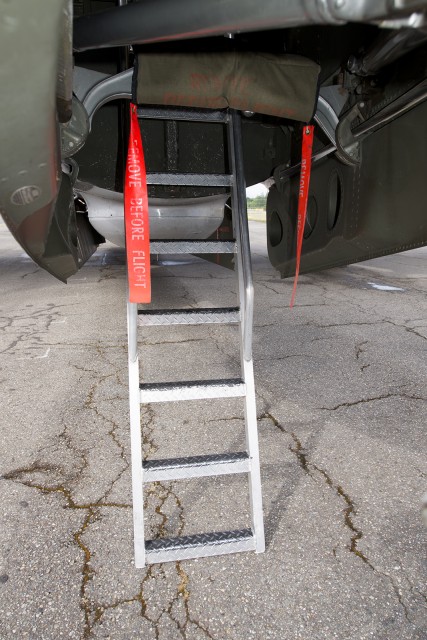
The boarding ladder for a B-29. It’s located in the nosewheel landing gear bay. Photo: Bernie Leighton | AirlineReporter
One then must step over the chasm-like hole of the crew entry hatch to get back to either the pilot or bombardier seats.
The bombardier seat itself folds down to facilitate easier entry. It also, unlike some aircraft I have flown on lately, has a seatbelt. Not a full shoulder belt, but a conventional lap-belt like on an airliner.
The view, however, is unparalleled. Especially with how spotless the windows are kept. This would be my seat for the flight.
Somehow, the B-29 is quieter on start up than an AN-2. I have no idea how this works, but there’s not much more to it than the lovely roar of the Wright R-3350s starting up and their wonderful hum and rattle while they idle.
What was strange, however, was how long it took after the aircraft lumbered down the taxiway to complete the run-up. I would later learn that this was because the magnetos on one of the engines were not operating in a manner that would be described as optimal. I lucked out, and eventually the aircraft was deemed safe for flight – however, for the next two days after my flight, the B-29 was grounded waiting for a spare part to arrive.
Finally, it was time to take off. We lurched towards the runway. For whatever reason, taxiing in the B-29 feels awkward. The aircraft flies amazingly (I’ll get to that in a bit), but taxiing includes a lot of creaking, awkward stopping, and lurches.
Takeoff was a thrill. The chorus from the engines at full throttle was beautiful; nothing sounded out of place or awkward. Acceleration was also very linear, smooth, and graceful. Rotation was fascinating, as I could see that the nosewheel was airborne for quite some time. It was almost a little disorienting to watch the runway speeding by underneath me. It’s not a sensation I am used to. Whether you are driving or flying, you never see the road underneath. It took about a minute to get used to.
Once in flight, FIFI felt extremely stable. Even though the weather was less-than-ideal and we were dodging clouds all over to maintain VFR, turbulence was barely noticeable. Just a few little bumps and the odd little rudder correction. I was surprised by how much I could notice the aircraft yawing, but it makes sense given how stable everything was.
The realization I had was that this would be amazing for upwards of about two hours – but that’s not what this aircraft was built for. No, it was an endurance bomber. Flown by men who were (at their oldest) usually in their mid-20’s into dangerous airspace where they might not come home. It’s a rather sobering thought. I was doing this for fun, but that just made me lucky.
Would I have been thrilled to crew this aircraft if I had no choice? Absolutely – and I’d have done my job with aplomb. After all, the B-29 was the aircraft of Major Thomas Ferebee. Still, a lot of B-29 crews never came home. We have to remember them. After all, not only did they end the war in the Pacific – they did their best in Korea as well.
Our course would take us to Whidbey Island Naval Air Station, where we would execute a turn, fly back down the coast and land at Paine. It’s certainly impressive to watch the ground. There’s not much to say about the flight back other than that the weather was getting worse and the ceiling was lowering.
We even flew through a rain shower on our final into PAE. However, that was not our actual final. We were setting up for a “photo pass” above the airfield. Unfortunately, I don’t think anyone got our picture, as aviation photographers are very pedantic about light.
I was just thrilled to be able to spend more time in that magnificent aircraft. I know it makes sense that bombers were built for stability, but I cannot stress how sturdy the aircraft felt in flight. It’s definitely a great platform from which to drop things – just bitterly outclassed today.
Landing itself was very smooth, even with the slight crosswind – I barely noticed us touching down on the giant tires. Truck landing gear was not feasible during wartime, hence why the B-29 has such a large, truly tricycle, set up.
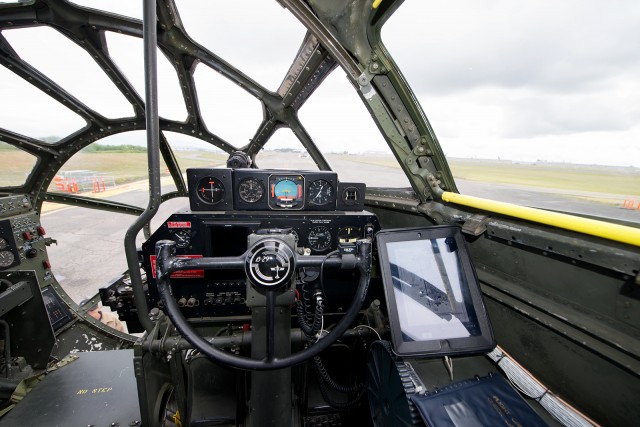
The first officer’s panel on a B-29 features an electronic flight bag – Photo: Bernie Leighton | AirlineReporter
The best part of the taxi home, other than another extended run up to double check the malfunctioning magneto, was being able to taxi past brand new 787s in a sixty-nine year old Boeing that is still going strong, with the addition of a tablet to act as an electronic flight bag. After all, the airspace is a lot more crowded and complex today than it was in 1945.
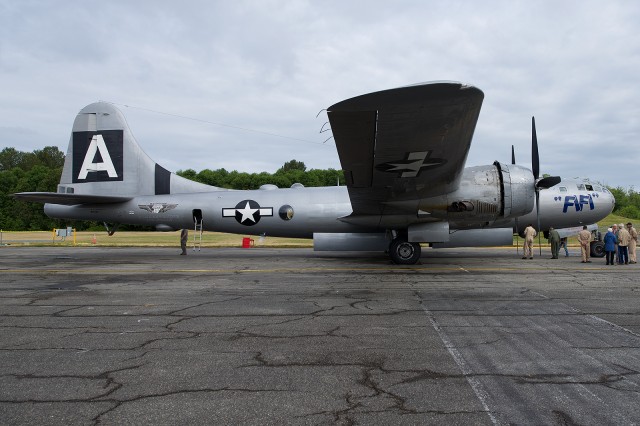
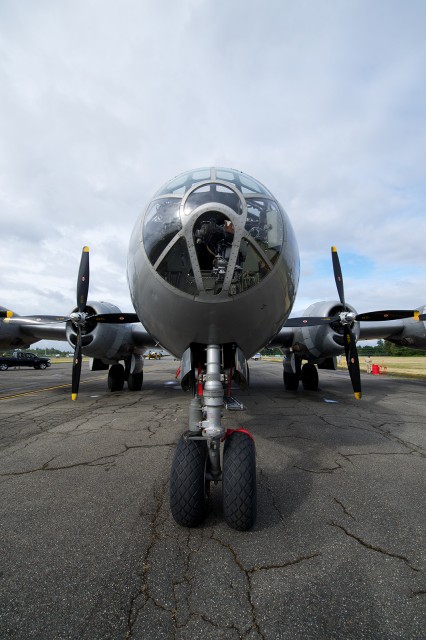
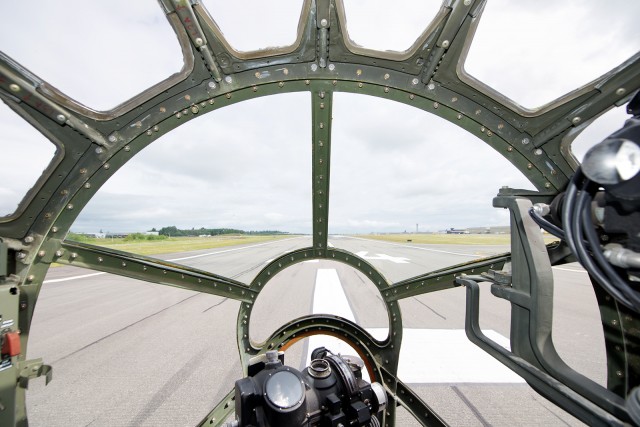
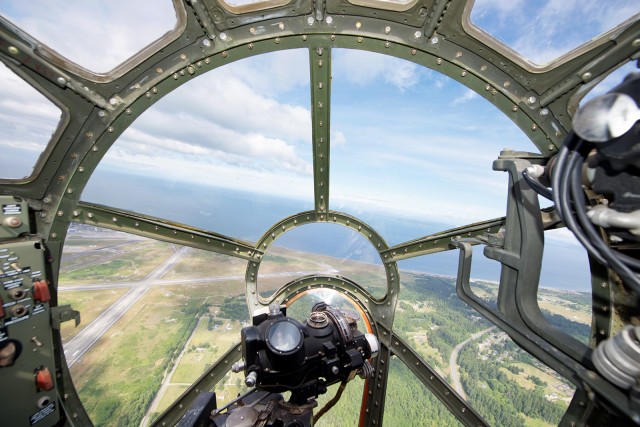
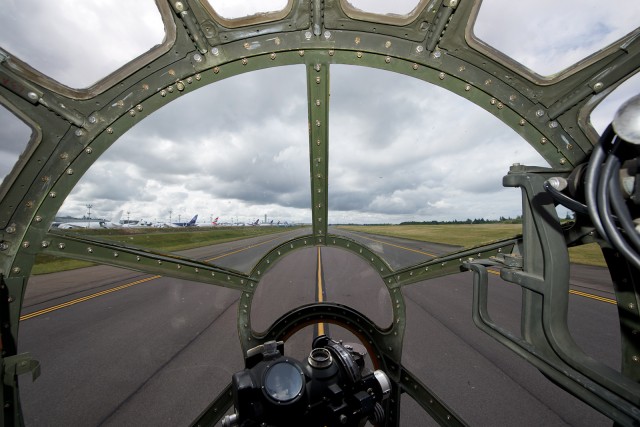
An excellent article sir, but I would like to point out one error in your narrative; your story states that all B-29s were built at the Seattle plant; I don’t think so, you see my dad was helping assemble them at the Bell Bomber plant, which is now occupied by Lockheed, at Marietta, Ga. on the day I was born, Feb.17, 1944.
A “Bell Bomber” search of Google provides very interesting reading and a lot of photos.
Doug Pellom
The Villages, Fl.
Still in use at Offutt AFB stands the Martin plant which produced 500 B-29s during the war, including the Enola Gay and Bockscar.
Doug Pellom is correct about Bell Bomber Plant in Marietta, Ga. My Father died in 1943, a Foreman in the Naval Yeard at Key West repairing damaged ships, and we moved from Miami to Marietta. My Mother got a job at Bell Sealing Fuel Tanks of B-29’s. I had an Uncle, Msgt J.D. Lunsford who was a B-29 Flight Engineer and flew out of Saipan and Tinian. He had to bail-out of B-29’s twice due to damage while flying to and from Japan.
He inspired my to enter the USAF later and I was an Aircraft Mechanic on B-47’s, B-58’s and a Flight Engineer/Instructor then Examiner on C-141B Aircraft. I spent 26 years in USAF both active and reserve. I also was a Mechanic on AT-6, C-47, P47, F83, F84, F105 and F4’s in The Georgia Air national Guard. Help I like airplanes. 32 years as A&P Mechanic, Foreman and Manager with Delta, Eastern, Northwest, United and US Airways